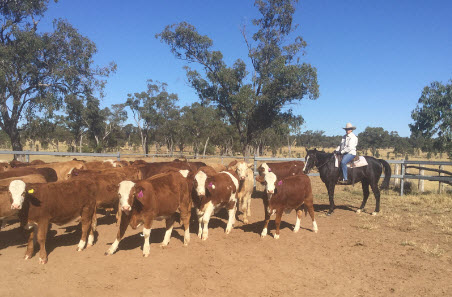Ready, set, feed
25 August 2017

By the time Jenny Walker sees pasture quality deteriorate, she is already using knowledge gained from an MLA Nutrition EDGE course to guide her in making cost-effective decisions.
Jenny, with her husband Rowly, daughters Briohny and Brogan, son Andrew and daughter-in-law Claire, runs 1,100 Simbrah breeders on 11,000ha in Mitchell, Queensland. Their enterprise is aimed at producing grain-finished animals for the EU market.
Understanding pasture triggers
Pasture quality and cow body condition are under constant scrutiny as the Walkers look for the environmental and physical triggers that indicate nutritional supplements are needed.
“Our country isn’t phosphorous or particularly mineral deficient; our biggest challenge is frost, which can happen anytime between May and August,” Jenny said.
“As soon as we get a frost, pasture protein disappears, digestibility falls and we know the cattle are losing weight and need supplementary nutrition.”
During the course, Jenny learnt how to interpret supplement labels and compare the cost of protein and energy/kilogram.
“We also learnt to assess how much pasture is available in a paddock in terms of dry matter/ha and how long that might last,” she said.
“For me, one of the most interesting revelations was grass quality and when it’s at its best.
“Pasture’s peak, for both nutritional value and digestibility, is when it’s lush, green and growing; by the time it’s gone to flower and seed, it’s already declining in protein and energy.
“The cattle are already starting to lose weight, yet it’s very difficult to detect through visual appraisal, so it is beneficial to supplement as soon as the grass is dry or frosted.”
Planning for nutritional needs
For ease of handling, the Walkers use dry licks made of cereal grain, urea, minerals and vitamins.
“We segregate our stock classes and supplement those with the highest nutritional needs, which are usually weaners, maiden heifers and late calvers,” Jenny said.
Urea content is introduced to weaners gradually, starting at 3% and building up to 10% of the lick; and for the rest of the herd is given up to 15% in the dry lick. This is to acclimatise the gut microbes to extract the maximum amount of protein and energy from the feed.
The Walkers use visual assessment of their stock’s condition to determine whether supplement amounts are sufficient but, following their attendance at a Nutrition EDGE workshop, they also send faecal samples to a Brisbane laboratory for analysis. The feedback determines any diet shortcomings.
Jenny said that due to a tough seasonal outlook forecast they were planning to wean some calves early and start feeding supplements to weaners and maiden heifers, and had already preg-tested and sold off the empties.
Lessons learned
- Dividing a cattle herd into stock classes and feeding supplements to those most in need helps control costs.
- Green, lush growing pasture is optimal for condition of animals; once pasture has flowered and gone to seed, its nutritional value is declining and the lactating cow is already losing condition.
More information:
Jenny Walker
E: iwonabeef@gmail.com
Would you like to attend a Nutrition EDGE workshop or organise one in your area? Go to www.mla.com.au/edgenetwork or contact course deliverer Désirée Jackson.


